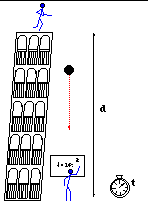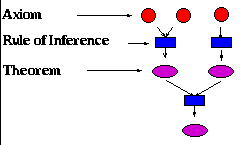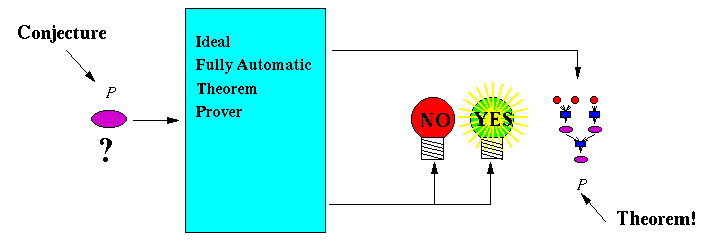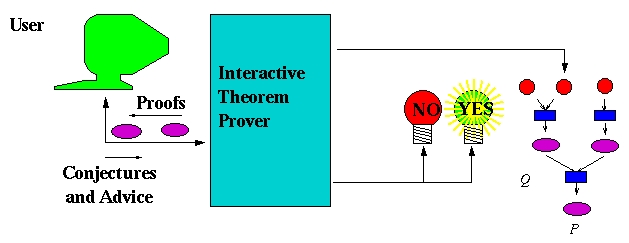
That completes the proof of *1.Summary Form: ( DEFTHM ASSOCIATIVITY-OF-APP ...) Rules: ((:REWRITE CDR-CONS) (:REWRITE CAR-CONS) (:DEFINITION NOT) (:DEFINITION ENDP) (:FAKE-RUNE-FOR-TYPE-SET NIL) (:DEFINITION APP)) Warnings: None Time: 0.27 seconds (prove: 0.10, print: 0.05, other: 0.12) ASSOCIATIVITY-OF-APP


This completes the Walking Tour.
We intend to document many other parts of the system this way, but we just haven't gotten around to it.
If you feel like reading more, see tutorial-examples in the documentation. There you will find several challenging but simple applications. At the conclusion of the examples is a simple challenge to try.
We hope you enjoy ACL2. We do.
Matt Kaufmann and J Strother Moore


At the conclusion of most events (click here for a
brief discussion of events or see events  ), ACL2 prints a
summary. The summary for
), ACL2 prints a
summary. The summary for app is:
Summary Form: ( DEFUN APP ...) Rules: ((:FAKE-RUNE-FOR-TYPE-SET NIL)) Warnings: None Time: 0.03 seconds (prove: 0.00, print: 0.00, other: 0.03) APP
The ``rules'' listed are those used in function admission or proof
summarized. What is actually listed are ``runes'' (see rune)  )
which are list-structured unique names for rules in the ACL2 data base or
``world''
)
which are list-structured unique names for rules in the ACL2 data base or
``world''  . Using theories
. Using theories  you can ``enable'' and
``disable'' rules so as to make them available (or not) to the ACL2
theorem prover.
you can ``enable'' and
``disable'' rules so as to make them available (or not) to the ACL2
theorem prover.
The ``warnings'' mentioned (none are listed for app) remind the
reader whether the event provoked any warnings. The warnings
themselves would have been printed earlier in the processing and
this part of the summary just names the earlier warnings printed.
The ``time'' indicates how much processing time was used and is
divided into three parts: the time devoted to proof, to printing,
and to syntactic checks, pre-processing and data base updates.
Despite the fact that ACL2 is an applicative language it is possible
to measure time with ACL2 programs. The state  contains a
clock. The times are printed in decimal notation but are actually
counted in integral units.
contains a
clock. The times are printed in decimal notation but are actually
counted in integral units.
The final APP is the value of the defun command and was
printed by the read-eval-print loop. The fact that it is indented
one space is a subtle reminder that the command actually returned an
``error triple'', consisting of a flag indicating (in this case)
that no error occurred, a value (in this case the symbol APP),
and the final state  ). See ld-post-eval-print
). See ld-post-eval-print
 for some details. If you really want to follow that link,
however, you might see ld
for some details. If you really want to follow that link,
however, you might see ld  first.
first.
You should now return to the Walking Tour.


Subgoal *1/2
(IMPLIES (AND (NOT (ENDP A))
(EQUAL (APP (APP (CDR A) B) C)
(APP (CDR A) (APP B C))))
(EQUAL (APP (APP A B) C)
(APP A (APP B C)))).

Click on the link above (the open parenthesis before ENDP)
to replace (ENDP A) by its definition.


Subgoal *1/2
(IMPLIES (AND (NOT (NOT (CONSP A)))
(EQUAL (APP (APP (CDR A) B) C)
(APP (CDR A) (APP B C))))
(EQUAL (APP (APP A B) C)
(APP A (APP B C)))).

The bold text is the instantiated definition of ENDP.
Now click on the link above to simplify (NOT (NOT (CONSP A)))


Subgoal *1/2'
(IMPLIES (AND (CONSP A)
(EQUAL (APP (APP (CDR A) B) C)
(APP (CDR A) (APP B C))))
(EQUAL (APP (APP A B) C)
(APP A (APP B C)))).

Note that this is Subgoal *1/2'.
You may click here to return to the main proof.



One particularly famous and very simple model is the equation of a falling body: the distance d an object falls is proportional to the square of the time t. If the time is measured in seconds and the distance in feet, the equation relating these two is
2
d = 16t
This equation is a model of falling objects. It can be used to predict how long it takes a cannonball to fall from the top of a 200 foot tower (3.5 seconds). This might be important if your product is designed to drop cannonballs on moving targets.
Click here to continue


Subgoal *1/1'
(IMPLIES (NOT (CONSP A))
(EQUAL (APP (APP A B) C)
(APP A (APP B C)))).

Click on the link above to replace (APP A B) by its definition.
Note that the hypothesis (NOT (CONSP A)) allows us to simplify
the IF in APP to its false branch this time.


Subgoal *1/1'
(IMPLIES (NOT (CONSP A))
(EQUAL (APP B C)
(APP A (APP B C)))).

Click on the link above to expand the definition of APP. Again,
we come out through the false branch because of the hypothesis.


Subgoal *1/1'
(IMPLIES (NOT (CONSP A))
(EQUAL (APP B C)
(APP B C))).

Click on the link above to use the Axiom (EQUAL x x) = t


Subgoal *1/1'
(IMPLIES (NOT (CONSP A))
T)

Now that its conclusion is identically T the IMPLIES
will simplify to T (not shown) and we are done with Subgoal *1/1'.
You may click here to return to the main proof.


So here we see our associativity rule being used!
The rewriter sweeps the conjecture in a leftmost innermost fashion, applying rewrite rules as it goes.
The associativity rule is used many times in this sweep. The first ``target'' is highlighted below. Click on it to see what happens:
Current Conjecture:
(equal (app (app (app (app x1 x2) (app x3 x4)) (app x5 x6)) x7)
(app x1 (app (app x2 x3) (app (app x4 x5) (app x6 x7)))))


(AND
(IMPLIES (AND (NOT (ENDP A)) ; Induction Step: test
(:P (CDR A) B C)) ; and induction hypothesis
(:P A B C)) ; implies induction conclusion.
(IMPLIES (ENDP A) (:P A B C))) ; Base Case
The formula beginning with this parenthesis is the induction scheme
suggested by (APP A B) applied to (P A B C).
It is a conjunction (AND  ) of two formulas.
) of two formulas.
The first is the induction step and the second is the base case.


This formula is the Induction Step. It basically consists of three parts, a test identifying the inductive case, an induction hypothesis and an induction conclusion.
(IMPLIES (AND (NOT (ENDP A)) ; Test
(:P (CDR A) B C)) ; Induction Hypothesis
(:P A B C)) ; Induction Conclusion
When we prove this we can assume
*Ais not empty, and that* the associativity conjecture holds for a ``smaller'' version of
A, namely,(CDR A).
Under those hypotheses we have to prove the associativity conjecture
for A itself.


The induction scheme just shown is just an abbreviation for our real goal.
To obtain our actual goals we have to replace the schema :P by
the associativity conjecture (instantiated as shown in the scheme).
This produces two actual goals, the induction step and the base case.


This paragraph explains why the induction selected is legal. The
explanation is basically the same as the explanation for why the
recursion in (APP A B) terminates.


Here is the theorem prover's output when it processes the defthm
command for the associativity of app. We have highlighted text
for which we offer some explanation, and broken the presentation into
several pages. Just follow the Walking Tour after exploring the
explanations.

ACL2!>(defthm associativity-of-app
(equal (app (app a b) c)
(app a (app b c))))
Name the formula above *1.
Perhaps we can prove *1 by induction. Three induction schemes are
suggested by this conjecture. Subsumption reduces that number to two.
However, one of these is flawed and so we are left with one viable
candidate.
We will induct according to a scheme suggested by (APP A B). If we
let (:P A B C) denote *1 above then the induction scheme we'll use
is
(AND
(IMPLIES (AND (NOT (ENDP A))
(:P (CDR A) B C))
(:P A B C))
(IMPLIES (ENDP A) (:P A B C))).
This induction is justified by the same argument used to admit APP,
namely, the measure (ACL2-COUNT A) is decreasing according to the relation
E0-ORD-< (which is known to be well-founded on the domain recognized
by E0-ORDINALP). When applied to the goal at hand the above induction
scheme produces the following two nontautological subgoals.
Q.E.D. stands for ``quod erat demonstrandum'' which is
Latin for ``which was to be demonstrated'' and is the signal that
a proof is completely done.


Note that under Rules we list the runes  of all
the rules used in the proof. This list says that we used the
rewrite rules
of all
the rules used in the proof. This list says that we used the
rewrite rules CAR-CONS and CDR-CONS, the definitions of the
functions NOT, ENDP and APP, and primitive type reasoning
(which is how we simplified the IF and EQUAL terms).
For what it is worth, IMPLIES and AND are actually
macros  that are expanded into
that are expanded into IF
expressions before the proof ever begins. The use of macros is not
reported among the rules.


Subgoal *1/2'
(IMPLIES (AND (CONSP A)
(EQUAL (APP (APP (CDR A) B) C)
(APP (CDR A) (APP B C))))
(EQUAL (APP (APP A B) C)
(APP A (APP B C)))).

Click on the link above to replace (APP A B) by its definition.


Subgoal *1/2'
(IMPLIES (AND (CONSP A)
(EQUAL (APP (APP (CDR A) B) C)
(APP (CDR A) (APP B C))))
(EQUAL (APP (IF (CONSP A)
(CONS (CAR A) (APP (CDR A) B))
B)
C)
(APP A (APP B C)))).

Note that the IF expression above is the simplified body of APP.
But we know the test (CONSP A) is true, by the first hypothesis.
Click on the link above to replace the test by T. Actually
this step and several subsequent ones are done during the simplification
of the body of APP but we want to illustrate the basic principles of
simplification without bothering with every detail.


Subgoal *1/2'
(IMPLIES (AND (CONSP A)
(EQUAL (APP (APP (CDR A) B) C)
(APP (CDR A) (APP B C))))
(EQUAL (APP (APP (CDR A) B) C)
(APP (CDR A) (APP B C)))).

Click on the link above to use the Induction Hypothesis (which is the
second of the two hypotheses above and which is identical to the rewritten
conclusion).


Subgoal *1/2'
(IMPLIES (AND (CONSP A)
(EQUAL (APP (APP (CDR A) B) C)
(APP (CDR A) (APP B C))))
T)

Click on the link above to use the definition of IMPLIES. Since
the conclusion of the implication is now identically T, the
implication simplifies to T.


Subgoal *1/2' T

So, indeed, Subgoal *1/2' does simplify to T!
You can see that even in an example as simple as this one, quite a lot happens in simplification.
You may click here to return to the main proof.


Subgoal *1/2'
(IMPLIES (AND (CONSP A)
(EQUAL (APP (APP (CDR A) B) C)
(APP (CDR A) (APP B C))))
(EQUAL (APP (IF T
(CONS (CAR A) (APP (CDR A) B))
B)
C)
(APP A (APP B C)))).

Click on the link above to apply the Axiom (IF T x y) = x.


Subgoal *1/2'
(IMPLIES (AND (CONSP A)
(EQUAL (APP (APP (CDR A) B) C)
(APP (CDR A) (APP B C))))
(EQUAL (APP (CONS (CAR A) (APP (CDR A) B))
C)
(APP A (APP B C)))).

Click on the link above to apply the expand the definition of APP here.


Subgoal *1/2'
(IMPLIES (AND (CONSP A)
(EQUAL (APP (APP (CDR A) B) C)
(APP (CDR A) (APP B C))))
(EQUAL (IF (CONSP (CONS (CAR A) (APP (CDR A) B)))
(CONS (CAR (CONS (CAR A) (APP (CDR A) B)))
(APP (CDR (CONS (CAR A) (APP (CDR A) B)))
C))
C)
(APP A (APP B C)))).

Click on the link above to apply the Axiom (CONSP (CONS x y)) = T.


Subgoal *1/2'
(IMPLIES (AND (CONSP A)
(EQUAL (APP (APP (CDR A) B) C)
(APP (CDR A) (APP B C))))
(EQUAL (IF T
(CONS (CAR (CONS (CAR A) (APP (CDR A) B)))
(APP (CDR (CONS (CAR A) (APP (CDR A) B)))
C))
C)
(APP A (APP B C)))).

Click on the link above to apply the Axiom (CAR (CONS x y)) = x.


Subgoal *1/2'
(IMPLIES (AND (CONSP A)
(EQUAL (APP (APP (CDR A) B) C)
(APP (CDR A) (APP B C))))
(EQUAL (IF T
(CONS (CAR A)
(APP (CDR (CONS (CAR A) (APP (CDR A) B)))
C))
C)
(APP A (APP B C)))).

Click on the link above to apply the Axiom (CDR (CONS x y)) = y.


Subgoal *1/2'
(IMPLIES (AND (CONSP A)
(EQUAL (APP (APP (CDR A) B) C)
(APP (CDR A) (APP B C))))
(EQUAL (IF T
(CONS (CAR A)
(APP (APP (CDR A) B)
C))
C)
(APP A (APP B C)))).

Click on the link above to apply the Axiom (IF T x y) = x.


Subgoal *1/2'
(IMPLIES (AND (CONSP A)
(EQUAL (APP (APP (CDR A) B) C)
(APP (CDR A) (APP B C))))
(EQUAL (CONS (CAR A)
(APP (APP (CDR A) B)
C))
(APP A (APP B C)))).

Click on the link above to expand the definition of APP here.
This time, we'll do the whole expansion at once, including the
simplification of the resulting IF. This is how ACL2 actually
does it.


Subgoal *1/2'
(IMPLIES (AND (CONSP A)
(EQUAL (APP (APP (CDR A) B) C)
(APP (CDR A) (APP B C))))
(EQUAL (CONS (CAR A)
(APP (APP (CDR A) B)
C))
(CONS (CAR A)
(APP (CDR A) (APP B C))))).

Click on the link above to apply the Axiom that
(EQUAL (CONS x y) (CONS u v)) is equal to the conjunction of
(EQUAL x u) and (EQUAL y v). In this case, (EQUAL x u)
is trivial, (EQUAL (CAR A) (CAR A)).


Note that at the conclusion of the proof, the system reminds you of the earlier Warning.
It is a good idea, when the Q.E.D. flys by, to see if there were
any Warnings.


ACL2!>(defthm associativity-of-app
(equal (app (app a b) c)
(app a (app b c))))
The formula above says app is associative. The defthm  command instructs ACL2 to prove the formula and to name it
command instructs ACL2 to prove the formula and to name it
associativity-of-app. Actually, the defthm command also
builds the formula into the data base as a rewrite  rule,
but we won't go into that just yet.
rule,
but we won't go into that just yet.
What we will consider is how the ACL2 theorem prover proves this formula.
If you proceed you will find the actual output of ACL2 in response to the command above. Some of the text is highlighted for the purposes of the tour. ACL2 does not highlight its output.
You will note that we sometimes highlight a single open parenthesis. This is our way of drawing your attention to the subformula that begins with that parenthesis. By clicking on the parenthesis you will get an explanation of the subformula or its processing.
The time it took us to explain this proof may leave the impression that the proof is complicated. In a way, it is. But it happens quickly.
The time taken to do this proof is about 1/10 second. The rest of the time (about 2/10 seconds) is spent in pre- and post-processing.
Basically, this proof flashes across your screen before you can read
it; you see the Q.E.D. and don't bother to scroll back to
read it. You have more important things to do than read successful
proofs.


ACL2 is a very large, multipurpose system. You can use it as a programming language, a specification language, a modeling language, a formal mathematical logic, or a semi-automatic theorem prover, just to name its most common uses.
This home page includes all of ACL2's online documentation, which is quite extensive. To help ease your introduction to ACL2, we have built two tours through this documentation.
Newcomers to ACL2 should first take the ``Flying Tour.'' Then, if you want to know more, take the ``Walking Tour.''
To start a tour, click on the appropriate icon below.
For readers using Web browsers: This ``page'' actually contains many other pages of our documentation, organized alphabetically and separated by many blank lines. Be careful when using the scroll bar!
For readers using our :DOC or our TexInfo format in Emacs: The tours
will probably be unsatisfying because we use gif files and assume you
can navigate ``back.''


This Warning alerts us to the fact that when treated as a
rewrite rule, the new rule TRIVIAL-CONSEQUENCE, rewrites
terms of the same form as a rule we have already proved, namely
ASSOCIATIVITY-OF-APP.
When you see this warning you should think about your rules!
In the current case, it would be a good idea not to make
TRIVIAL-CONSEQUENCE a rule at all. We could do this with
:rule-classes  nil.
nil.
ACL2 proceeds to try to prove the theorem, even though it printed
some warnings. The basic assumption in ACL2 is that the user
understands what he or she is doing but may need a little reminding
just to manage a complicated set of facts.


This topic has not yet been documented. Sorry


If we have proved the associativity-of-app rule, then the
following theorem is trivial:
(defthm trivial-consequence
(equal (app (app (app (app x1 x2) (app x3 x4)) (app x5 x6)) x7)
(app x1 (app (app x2 x3) (app (app x4 x5) (app x6 x7))))))
Below we show the proofACL2 is a mathematical logic together with a mechanical theorem prover to help you reason in the logic.
The logic is just a subset of applicative Common Lisp.
The theorem prover is an ``industrial strength'' version of the Boyer-Moore theorem prover, Nqthm.
Models of all kinds of computing systems can be built in ACL2, just as in Nqthm, even though the formal logic is Lisp.
Once you've built an ACL2 model of a system, you can run it.
You can also use ACL2 to prove theorems about the model.
It is not easy to build ACL2 models of complex systems. To do so, the user must understand
* the system being modeled, and* ACL2, at least as a programming language.
It is not easy to get ACL2 to prove hard theorems. To do so, the user must understand
* the model,ACL2 will help construct the proof but its primary role is to prevent logical mistakes. The creative burden -- the mathematical insight into why the model has the desired property -- is the user's responsibility.* ACL2 as a mathematical logic, and
* be able to construct a proof (in interaction with ACL2).

A mathematical logic is a formal system of formulas (axioms) and rules for deriving other formulas, called theorems.
A proof is a derivation of a theorem. To see a concrete proof tree, click here.
Why should you care? The neat thing about Theorems is that they are ``true.'' More precisely, if all the axioms are valid and the rules are validity preserving, then anything derived from the axioms via the rules is valid.
So, if you want to determine if some formula is true, prove it.
A mechanical theorem prover is a computer program that finds proofs of theorems.

The ideal mechanical theorem prover is automatic: you give it a formula and it gives you a proof of that formula or tells you there is no proof.
Unfortunately, automatic theorem provers can be built only for very simple logics (e.g., propositional calculus) and even then practical considerations (e.g., how many centuries you are willing to wait) limit the problems they can solve.
To get around this, mechanical theorem provers often require help from the user.

Click here to continue downward.
This is good and bad.
The good news is that you can program ACL2's simplifier.
The bad news is that when you command ACL2 to prove a theorem you must give some thought to how that theorem is to be used as a rule!
For example, if you engaged in the mathematically trivial act of proving the associativity rule again, but with the equality reversed, you would have programmed ACL2's rewriter to loop forever.
You can avoid adding any rule by using the command:
(defthm associativity-of-app
(equal (app (app a b) c)
(app a (app b c)))
:rule-classes nil)